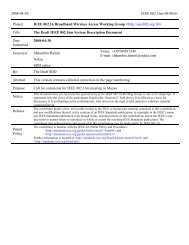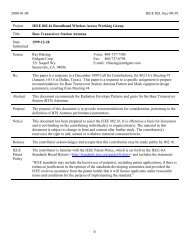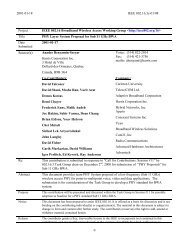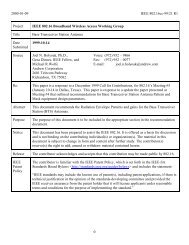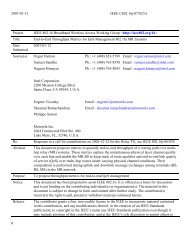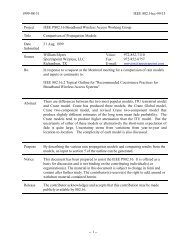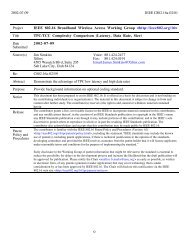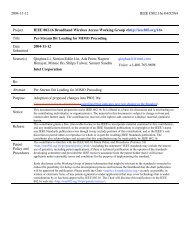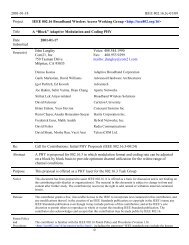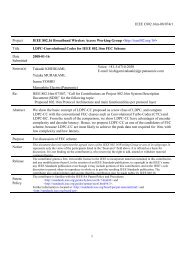802.16.1 Functional Requirements, Rev. 1 - LMSC, LAN/MAN ...
802.16.1 Functional Requirements, Rev. 1 - LMSC, LAN/MAN ...
802.16.1 Functional Requirements, Rev. 1 - LMSC, LAN/MAN ...
You also want an ePaper? Increase the reach of your titles
YUMPU automatically turns print PDFs into web optimized ePapers that Google loves.
123456789101112131415161999-12-17 IEEE 802.16s-99/00r1The <strong>802.16.1</strong> protocols MUST be capable of dedicating constant-rate, provisioned, bandwidth forbearer services such as SDH/PDH. For instance, the MAC layer MAY employ TDM allocationof bandwidth within a channel for these services. TDM bandwidth allocation may be performeddynamically to allow for both 1) turning up fixed-bandwidth Permanent Virtual Circuits (PVCs)and 2) for dynamically changing bandwidth of a virtual circuit once it has been established.For QoS-based, connectionless, but not circuit-based, bearer services, the <strong>802.16.1</strong> protocolsMUST support bandwidth negotiation “on-demand” [9]. For instance, the MAC protocol MAYallocate bursts of time slots to bearer services that require changes in bandwidth allocation. Suchallocation is thus performed in a semi-stateless manner. A connection-oriented bearer service mayrequire “state” information to be maintained for the life of a connection. But the <strong>802.16.1</strong> MAClayer interface MAY provide a connection-less service interface that requires a higher-layer“adaptation” to maintain the “state” of a connection and periodically allocate bandwidth. Forinstance, the MAC may need to maintain “state” information about a QoS data flow only for theduration of an allocation.Bearer ServiceHigh Quality Narrowband/VoiceFrequency Telephony (VocoderMOS ≥ 4.0)Lower Quality Narrowband/VoiceFrequency Telephony (VocoderMOS < 4.0)Table 1: Services and QoS <strong>Requirements</strong>MAC Payload MaximumRate RatioCircuit-Based32 kbps – 64 kbps 10 -6BER6 kbps – 16 kbps 10 -4Trunking



